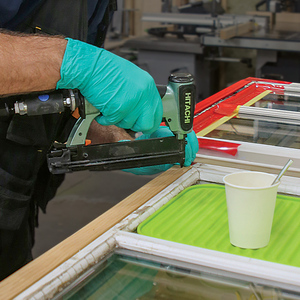I need to replace the old, corroded shut-off valves for my washer. I also plan to replace some/all of the old, presumably partially plugged iron pipe, with CPVC. When I looked at the plastic ball valves at the big box they looked pretty flimsy and were really stiff/hard to operate. The brass ball valves on the other hand seem quite solid and have a nice feel. Are the plastic OK long term, or should I mix plastic pipe with brass valves, or…? Thanks.
Thon



















Replies
You can buy a 'washing machine box', which is a plastic enclosure that holds shutoff valves for the hot and cold and also has connection for the 2" drain. The whole thing recesses into the wall, so you need the wall open, or at least part of it. The one I use has a single lever that shuts off both hot and cold. It has brass male pipe thread stubbed out of the bottom of the valve, so you either sweat copper to it or use thread adapters for PVC, pex, whatever your pipe is.
http://www.oatey.com
check out the 'quadtro' link, there are at least a dozen varieties.
But that's not what you asked. If I were using ball valves I'd buy the brass ones (hopefully Italian) and threaded adapters for them so I could screw the plastic pipe to them.
Edited 4/26/2004 11:55 am ET by davidmeiland
Watch out, some of those Italian ball valves don't have adjustable packing (the seal around the handle).
The best ball valves, in my opinion, have the nut under the handle for tightening the packing if it ever leaks.
Also look for "full flow" so there is no reduction of flow (the hole is larger on the inside).
Norm
We have a globe valve and a tank valve with a float in every stock tank on the pipeline.
They need replacing regularly because the cattle get in the tank and break them or they get corroded.
When replacing them long ago, the hardware told me that "all were going to the plastic ones because they didn't corrode in the tanks".
I changed many to the plastic ones but they lasted even less time than the brass ones. They cracked, got stiff and broke and were hard to work with in the cold, would split.
Now we are back to the ones with a round top and a nut to tighten or the long single handle.
In your case, the plastic ones may work ok...
One problem with the plastic ones is that the materials is, well, plastic. That is, it flows. Easily at its melting point but a little bit when under pressure. So the ball in the ball valve conforms to the shape it is in (open or closed) and that makes it hard to turn.
It therefore requires more force through that valve stem and it is, guess what, plastic! So the stem or the handle breaking is another problem.
Ruby may be seeing problems related to UV exposure which no plastics like and causes PVC especially, to get brittle. Plus he has cows swimming in the tanks and stepping on the valves!
Plastic is great for acid. Otherwise I use brass-bodied, SS-ball, ball valves.
It's normal for plastic ball valves to be stiffer than brass ones. It's done on purpose because it's necessary to get a proper seal with plastic. Plastic ball valves can work fine in clean water (and in some very nasty chemicals are the only ones that work). But, grit and temperatures above 180°F (140°F for PVC) can cause damage.
CPVC can work fine for the washing machine. But, it's not really the most durable. When a washing machine shuts off it generates a pressure shock which CPVC should be able to withstand, but if it's high enough and often enough, you may have trouble. Annually, insurance companies pay out around $150,000,000 for water damage from washing machines.
If you connect CPVC to metal, you should use the CPVC to metal adapter fittings, rather than just screwing a plastic thread into a metal thread, or vice versa. Because plastic and metal have such different coeficients of thermal expansion, every temperature change will work the threads and eventually they'll leak. Hot water can cause leaks fairly quickly. So, no, it is not a good idea to use brass valve in plastic piping systems.
I recommend this: the washing machine hook up box as one of the other posters suggested. To the outlet of the valves, attach screw on shock absorbers made for washing machine valves. Use only the stainless steel hoses to connect to the machine. Run copper from your old piping to the new box. If you have to connect the new copper to iron anywhere in the system, make the connection using dielectric unions. You may have to go to a plumbing supply house for these. If you omit the dielectric unions, you will accelerate the rusting of the iron and give you problems. Anywhere in your system where you might have any brass or copper conected to iron (such as a brass valve in iron piping) you are generating corrosion which is eating away at your pipes and creating crud which can clog things up.
OK, I'm dissuaded from the plastic ball valves and will use brass. Never liked the plastic anyway. :-)
<When a washing machine shuts off it generates a pressure shock which CPVC should be able to withstand, but if it's high enough and often enough, you may have trouble. >
I understand what you're saying here, and why--I think--but can't say I'ver ever seen anything about this. Any references?
Thanks again for all the help.
Thon
Think of it this way, the water that's flowing from the water main or wellpump, thru your house and to the washer has a fair bit of mass and momentum to it. When the washer solenoid valve "quickly" closes it has to stop all of that moving water and all of that energy of the moving water, that energy has to disipated somewhere and since the valve's doing the stopping it absorbs most the energy. It's kinda like getting slammed by a wave at the beach.
MikeMike
It's O.k. to think out of the box, Just don't walk off of the plank!
As I said, I understand what's happening (not really much different than pushing a water saver shower valve), I'm just interested in whether there's any 'science' backing up the theory.
Thon
yes, it is just as Mike exlained it.
not theory, fact.
Norm
"(not really much different than pushing a water saver shower valve)"
It's the quicker speed at which the washer's solenoid valve closes that makes all of the difference
Here's some science from http://www.plastomatic.com/water-hammer.html
The Effects of Water Hammer And Pulsations
Quick closing valves, positive displacement pumps, and vertical pipe runs can create damaging pressure spikes, leading to blown diaphragms, seals and gaskets also destroyed meters and gauges.
Liquid for all practical purposes is not compressible, any energy that is applied to it is instantly transmitted. This energy becomes dynamic in nature when a force such as quick closing valve or a pump applies velocity to the fluid.
Surge (Water Hammer)
Surge or water hammer, as it is commonly known is the result of a sudden change in liquid velocity. Water hammer usually occurs when a transfer system is quickly started, stopped or is forced to make a rapid change in direction. Any of these events can lead to catastrophic system component failure. Without question, the primary cause of water hammer in process applications is the quick closing valve, whether manual or automatic. A valve closing in 1.5 sec. or less depending upon valve size and system conditions, causes an abrupt stoppage of flow. The pressure spike(acoustic wave)created at rapid valve closure can be high as five(5) times the system working pressure.
Unrestricted, this pressure spike or wave will rapidly accelerate to the speed of sound in liquid, which can exceed 4000 ft/sec. It is possible to estimate the pressure increase by the following formula.
View Image
Importance of Using this Formula While there are many online water hammer calculators, we have found wide variety in the results. We therefore recommend using old fashioned pencil and paper and this formula:
Water Hammer Formula: P = (0.070) (V) (L) / t + P1
Where P = Increase in pressure
P1 = Inlet Pressure
V = Flow velocity in ft/sec
t = Time in sec.(Valve closing time)
L = Upstream Pipe Length in feet
Here's an example of pressure hammer when closing an EASMT solenoid valve, with a 50 ft long upstream pipe connection: L = 50 ft
V = 5.0 ft / sec( recommended velocity for PVC piping design)
t = 40 ms(solenoid valve closing time is approx. 40-50 ms)
P1 = 50 psi inlet pressure
therefore, P = 0.07 x 5 x 50 / 0.040 + P1
or P = 437.5 psi + P1
Total Pressure = 437.5 + 50 = 487.5 psi
Hope this helps
Mike
It's O.k. to think out of the box, Just don't walk off of the plank!
I understand (still! :-) ) the theory behind this.
What I was asking for was some research showing that CPVC in a washing mashine supply line couldn't take those surges.
Thon
Thon
My mistake, I thought it was the pressure surge that you wanted info on, not info on the CPVC valves failing.
Mike
It's O.k. to think out of the box, Just don't walk off of the plank!
No problem. Always nice to see some physics again--it's been a long, long, time. ;-)
Thon